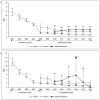Methodological Considerations for Comparison of Brand Versus Generic Versus Authorized Generic Adverse Event Reports in the US Food and Drug Administration Adverse Event Reporting System (FAERS)
- PMID: 28933038
- PMCID: PMC5842081
- DOI: 10.1007/s40261-017-0574-4
Methodological Considerations for Comparison of Brand Versus Generic Versus Authorized Generic Adverse Event Reports in the US Food and Drug Administration Adverse Event Reporting System (FAERS)
Abstract
Background: The US Food and Drug Administration Adverse Event Reporting System (FAERS), a post-marketing safety database, can be used to differentiate brand versus generic safety signals.
Objective: To explore the methods for identifying and analyzing brand versus generic adverse event (AE) reports.
Methods: Public release FAERS data from January 2004 to March 2015 were analyzed using alendronate and carbamazepine as examples. Reports were classified as brand, generic, and authorized generic (AG). Disproportionality analyses compared reporting odds ratios (RORs) of selected known labeled serious adverse events stratifying by brand, generic, and AG. The homogeneity of these RORs was compared using the Breslow-Day test. The AG versus generic was the primary focus since the AG is identical to brand but marketed as a generic, therefore minimizing generic perception bias. Sensitivity analyses explored how methodological approach influenced results.
Results: Based on 17,521 US event reports involving alendronate and 3733 US event reports involving carbamazepine (immediate and extended release), no consistently significant differences were observed across RORs for the AGs versus generics. Similar results were obtained when comparing reporting patterns over all time and just after generic entry. The most restrictive approach for classifying AE reports yielded smaller report counts but similar results.
Conclusion: Differentiation of FAERS reports as brand versus generic requires careful attention to risk of product misclassification, but the relative stability of findings across varying assumptions supports the utility of these approaches for potential signal detection.
Conflict of interest statement
Figures






Similar articles
-
Comparison of brand versus generic antiepileptic drug adverse event reporting rates in the U.S. Food and Drug Administration Adverse Event Reporting System (FAERS).Epilepsy Res. 2017 Sep;135:71-78. doi: 10.1016/j.eplepsyres.2017.06.007. Epub 2017 Jun 13. Epilepsy Res. 2017. PMID: 28641219 Free PMC article.
-
Brand vs generic adverse event reporting patterns: An authorized generic-controlled evaluation of cardiovascular medications.J Clin Pharm Ther. 2018 Jun;43(3):327-335. doi: 10.1111/jcpt.12646. Epub 2017 Nov 1. J Clin Pharm Ther. 2018. PMID: 29092097 Free PMC article.
-
An Algorithm to Identify Generic Drugs in the FDA Adverse Event Reporting System.Drug Saf. 2017 Sep;40(9):799-808. doi: 10.1007/s40264-017-0550-1. Drug Saf. 2017. PMID: 28593504 Free PMC article.
-
Analysis of Spontaneous Postmarket Case Reports Submitted to the FDA Regarding Thromboembolic Adverse Events and JAK Inhibitors.Drug Saf. 2018 Apr;41(4):357-361. doi: 10.1007/s40264-017-0622-2. Drug Saf. 2018. PMID: 29196988 Review.
-
Can Disproportionality Analysis of Post-marketing Case Reports be Used for Comparison of Drug Safety Profiles?Clin Drug Investig. 2017 May;37(5):415-422. doi: 10.1007/s40261-017-0503-6. Clin Drug Investig. 2017. PMID: 28224371 Review.
Cited by
-
Contrastive analysis on the safety of brand and generic nebivolol: a real-world pharmacovigilance study based on the FDA adverse event reporting system.Front Pharmacol. 2024 Jan 31;15:1280201. doi: 10.3389/fphar.2024.1280201. eCollection 2024. Front Pharmacol. 2024. PMID: 38357307 Free PMC article.
-
Detecting and Filtering Immune-Related Adverse Events Signal Based on Text Mining and Observational Health Data Sciences and Informatics Common Data Model: Framework Development Study.JMIR Med Inform. 2020 Jun 12;8(6):e17353. doi: 10.2196/17353. JMIR Med Inform. 2020. PMID: 32530430 Free PMC article.
-
Impact and implications of national centralized drug procurement in China.Int J Clin Pharm. 2024 Dec;46(6):1557-1562. doi: 10.1007/s11096-024-01767-1. Epub 2024 Jul 11. Int J Clin Pharm. 2024. PMID: 38990456
-
Safety of Marketed Cancer Supportive Care Biosimilars in the US: A Disproportionality Analysis Using the Food and Drug Administration Adverse Event Reporting System (FAERS) Database.BioDrugs. 2021 Mar;35(2):239-254. doi: 10.1007/s40259-020-00466-3. Epub 2021 Jan 13. BioDrugs. 2021. PMID: 33439472
-
Adverse event profiles of solvent-based and nanoparticle albumin-bound paclitaxel formulations using the Food and Drug Administration Adverse Event Reporting System.SAGE Open Med. 2019 Mar 11;7:2050312119836011. doi: 10.1177/2050312119836011. eCollection 2019. SAGE Open Med. 2019. PMID: 30886713 Free PMC article.
References
-
- [Accessed November 28, 2016];Generic Pharmaceutical Association (GPhA) 2016 Generic Drug Savings & Access in the United States Report. http://www.gphaonline.org/media/generic-drug-savings-2016/index.html.
-
- Crawford P, et al. Are there potential problems with generic substitution of antiepileptic drugs? A review of issues. Seizure. 2006;15(3):165–76. - PubMed
-
- Erickson SC, et al. Clinical and pharmacy utilization outcomes with brand to generic antiepileptic switches in patients with epilepsy. Epilepsia. 2011;52(7):1365–71. - PubMed
Publication types
MeSH terms
Substances
Grants and funding
LinkOut - more resources
Full Text Sources
Other Literature Sources
Medical

